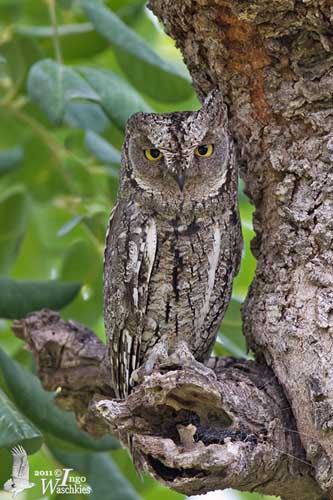
Fr: Petit-duc scops
All : Zwergohreule
Esp: Autillo Europeo
Ital : Assiolo comune
Nd: Dwergooruil
Sd: Dvärguv
Port : Mocho-d'orelhas
Photographers:
Aurélien Audevard
OUESSANT DIGISCOPING
Jean Michel Fenerole
Photos d’Oiseaux du monde
Ingo Waschkies
Bird Photography
Text by Nicole Bouglouan
Sources:
HANDBOOK OF THE BIRDS OF THE WORLD Vol 5 by Josep del Hoyo-Andrew Elliott-Jordi Sargatal - Lynx Edicions - ISBN: 8487334253
BIRDS OF THE GAMBIA AND SENEGAL by Clive Barlow and Tim Wacher – Helm Field guides – ISBN: 0713675497
BIRDS OF THE MIDDLE EAST by R.F. Porter, S. Christensen, P Schiermacker-Ansen C.Helm - ISBN: 0713670169
THE HANDBOOK OF BIRD IDENTIFICATION FOR EUROPE AND THE WESTERN PALEARCTIC by Mark Beaman, Steve Madge - C.Helm - ISBN: 0713639601
BirdLife International (BirdLife International)
Eurasian Scops Owl
Otus scops
Strigiforme Order – Strigidae Family
BIOMETRICS:
Length: 19-20 cm
Wingspan: 53-63 cm
Weight: 92-145 g
DESCRIPTION:
The Eurasian Scops Owl may become invisible when resting in trees by day, thanks to its cryptic plumage.
This is a small owl with heavily streaked plumage, but it varies in colours from grey, to brown and rufous according to individuals and races.
The back is spotted white and scapulars are streaked pale greyish-white. We can see a white collar spotted sepia. The tail is greyish, streaked dark and black, and barred by 4-5 whitish bands.
On the head, two ear tufts are visible on crown sides. They can erect and are grey-brown. The eyes are yellow. The bill is bluish-black. Legs and feet are brown to reddish-brown, following the plumage variations.
The juvenile resembles adult but it is paler, with less rufous, shorter ear tufts and some small white spots on the lower part of scapulars. The dark streaks of the upperparts are less conspicuous, and narrower on the underparts.
We can find six subspecies sharing the wide range. They differ in plumage colour and intensity of dark pattern.
O.s. scops, nominate race here described; O.s. pulchellus is paler; O.s. mallorcae is smaller with more markings; O.s. cycladum has coarser and darker pattern; O.s. cyprius is the darkest race; O.s turanicus is pale silvery-grey.

VOICE: SOUNDS BY XENO-CANTO
The Eurasian Scops Owl has monotonous voice but however fairly melodious. It is a single “kiou” strongly repeated by the male. Other sounds can be heard, uttered as well at nest as when the bird is alarmed.
When the female responds to the male, her voice is slightly higher-pitched and usually includes 2-3 syllables “yi-ou-ou”. We can also hear some mewing when the bird is alarmed, or a short, shrill “ri-ii”.
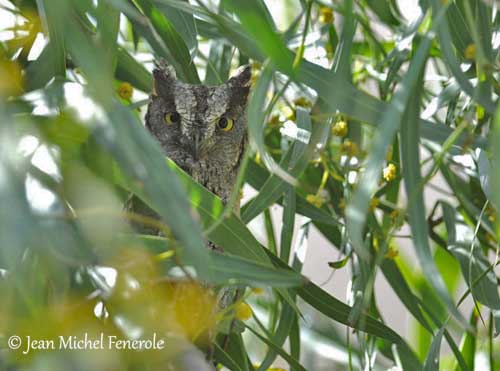
HABITAT:
The Eurasian Scops Owl frequents the large, open, deciduous forests, groves, orchards, parks, large gardens, cultivated areas with scattered trees, and locally the open conifer forests.
RANGE:
The Eurasian Scops Owl winters in southern Europe and in Africa, south of the Sahara.
It breeds in a wide area from NW Africa to Asia, through Europe (France, Spain, Italia, Switzerland, Czechoslovakia, Yugoslavia and Balkans), and all the Mediterranean islands where it is associated to olive groves.
BEHAVIOUR:
The Eurasian Scops Owl remains motionless against the bark of the tree trunk if threatened. Its cryptic plumage makes it invisible. It really melts into the background. This bird is mainly nocturnal, but it sings and can be regularly active by day.
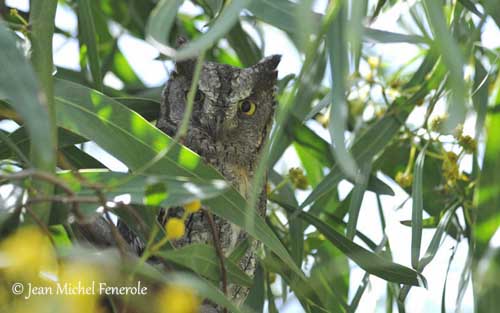
During the breeding season, they live in pairs, but when they migrate, they gather in small groups.
The Eurasian Scops Owl performs the characteristic displays of Strigidae involving courtship feeding by male to female, during which the male moves wings and body. Both mates perform mutual preening too, in order to strengthen the pair-bonds, and as pre- and post-copulatory behaviour.
They frequently utter duets during the displays.
This owl is often seen near the street lamps where insects are abundant. It is very agile when flying among them to catch preys.
The Eurasian Scops Owl is migratory. The most part of the European population migrates in autumn and reaches inland Africa in a single flight, maybe close to the Sahara.
It likes the vicinity of humans. It can be seen in towns and cities where the lights attract insects which are its main food. But it also knows how to keep its distance from humans.
It spends the day motionless against a tree trunk where it becomes invisible. It starts to hunt again at dusk, after singing during long time.
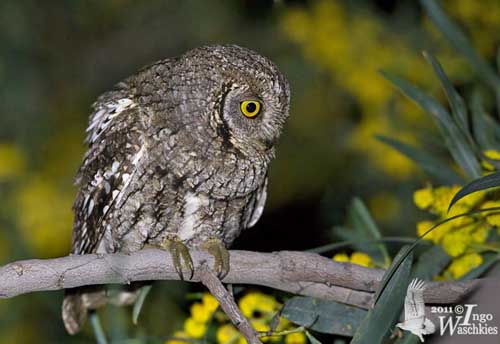
The female lays 3-6 white, fairly rounded eggs. The incubation lasts 24-25 days, mainly by the female. She is fed by the male which carries preys at nest, as it does too for the chicks, and the female feeds them with the preys brought by the male. Both adults feed them until they fledge, at about 21-29 days of age, although their plumage is not completely grown. The head and some parts of the body still show down. They are able to fly at one month old, but they still depend on parents for five weeks more.
DIET:
The Eurasian Scops Owl is mainly insectivorous. In June-July, the grasshoppers are the main preys. It also consumes a lot of Lepidoptera in August. This is the moment for the bird to make its fat reserves before the migration. Important differences of weight are noticed: 66-92 grams in spring and 60-145 grams in autumn. It also catches flying ants during the hottest days, but also sometimes, small mice and birds.
PROTECTION / THREATS / STATUS:
The Eurasian Scops Owl is often invisible due to the cryptic plumage, making difficult to have an idea of its numbers.
Some declines are observed, due to the use of pesticides in some parts of the range, habitat destruction and fragmentation for agriculture expansion, and reduction of insect populations and lack of hollow trees.
However, this species is not currently threatened.
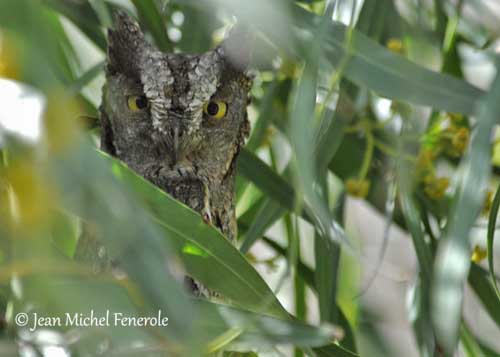
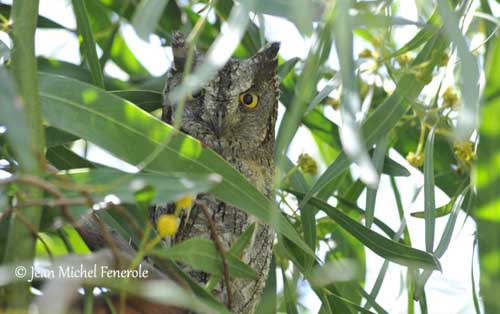
FLIGHT:
The Eurasian Scops Owl flies without strong undulations when taking off. The series of wingbeats are interspersed with glides on down-curved wings.
REPRODUCTION:
The breeding season varies according to the range, but usually occurs between March and August.
The Eurasian Scops Owl’s nest is often a hole in old tree trunk, or an abandoned woodpecker hole, at some height. There is not addition of other materials. It also may use cavities in walls of old buildings, or under roofs of cabins in parks and gardens.
The species is monogamous, and may be occasionally polygynous. The pair forms in March but the laying only occurs one month later.
